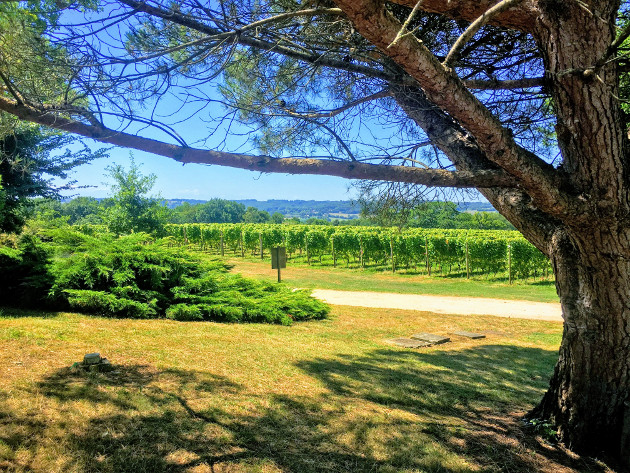
Visiting the Plaimont Producteurs in Southwest France
–
Zu Besuch bei den Plaimont Producteurs in Südwestfrankreich
Before my visit to Gascony I did not really know why this region is so strongly in the shadow of the famous neighbor region Bordeaux. Qualitatively, the southwest in France does not need to hide. Both, wine and food are very authentic and of high quality in creation and production. The climate and soil structure are also ideal for viticulture. Geographically, here in Gascony you are close to nature and beautifully embedded between two seas. The Atlantic Sea to the west, the Mediterranean Sea to the east and the Pyrenees Mountains to the south are the dominating climatic influences of the region.
–
Vor meinem Besuch in die Gascogne war mir nicht so recht klar, weshalb dies Region so stark im Schatten der berühmten Nachbarregion Bordeaux steht? Qualitativ muss sich der Südwesten in Frankreich nicht verstecken. Sowohl Wein als auch Speisen sind hier sehr authentisch und aus hochwertiger Produktion und Herstellung. Auch das Klima und die Bodenstruktur sind ideal für den Weinbau geeignet. Geographisch liegt man hier naturnah und wunderschön zwischen zwei Meeren eingebettet. Die dominierenden Klimaeinflüsse der Region kommen vom Atlantik im Westen, vom Mittelmeer im Osten und von den nahegelegenen Pyrenäen im Süden.

l: Ex Exportleiter Philippe Antony, Plaimont Direktor Olivier Bourdet-Pees, Export Director Mac Vachet, Jean Aymes Marketing Director (Foto: Batin Mumcu)
Only if you visited both regions, you will understand why the more “sophisticated Bordeaux” wants to confine itself so vehemently from the southwest. Without generalizing or even depreciating, I ended up here in the southwest of France in a beautiful village in the middle of nowhere. For me, even more than in Burgundy, the Gascogne region presents itselfs very traditional and original.
–
Nur wenn Sie beide Regionen einmal persönlich besucht haben, werden Sie erkennen weshalb sich das eher „sophisticated Bordeaux“ so vehement vom Südwesten abgrenzen will. Ohne dies zu pauschalisieren oder gar abzuwerten, bin ich hier im Südwesten Frankreichs, in einem wunderschönen Dorf im nirgendwo gelandet. Hier präsentiert sich für mich, noch mehr als im Burgund, die Region Gascogne sehr traditionell und ursprünglich.
Chateaus of the Plaimont Producteurs – Chateaus der Plaimont Producteurs

Chateau de Cassaigne (Foto: Batin Mumcu)
Castles and palaces, as well as the saga about the “Three Musketeers” are somehow still alive here. The production of the foie gras, which is very controversial discussed in Berlin, also finds its Mecca here and even represents the regional specialty. After a few attempts to approach the goose liver culinary, I prefer to devote myself to my actual passion and the main reason of my journey, the Wine.
–
Burgen und Schlösser, sowie die Saga um die „Drei Musketiere“ sind hier noch sehr lebendig. Auch die bei uns in Berlin sehr umstrittene Herstellung der Gänseleber findet hier sein Mekka und stellt sogar die regionale Spezialität dar. Nach einigen Versuchen mich der Gänseleber kulinarisch zu nähern, widme ich mich dann doch lieber meiner eigentlichen Leidenschaft und dem Hauptgrund meiner Reise, dem Wein.
Wine-Introduction / Wein-Empfehlung
“2014 Monastére De Saint-Mont”
Monastère de Saint-Mont Monastery was founded around 1050 by the monks of Cluny (Burgundy). Archived writings from 1055 regulated the cooperation of the monks and the peasants of the area. Producteurs Plaimont has researched the exact locations of the monastery plots and recreated the vineyards together with the current owner. Today, seven winemakers manage these historic sites with all their skills and produce this unique and strong Saint-Mont wine.
–
Das Kloster Monastère de Saint-Mont wurde gegen 1050 von den Mönchen von Cluny (Burgund) gegründet. Archivierte Schriften
aus dem Jahre 1055 regelten die Zusammenarbeit der Mönche und der Bauern der Umgebung. Producteurs Plaimont hat die genauen Lagen der Klosterparzellen erforscht und die Weinberge zusammen mit dem heutigen Besitzer wieder neu angelegt. Heute bewirtschaften sieben Winzer diese historischen Anlagen mit Ihrem ganzen Können und bringen diesen einzigartigen und kräftigen Saint-Mont-Wein hervor.
Grapes/Rebsorten: Tannat 60%, Pinenc 20%, Cabernet 20% | Terroir: Lehmboden, kühles Klima, Nordosthänge |
Maturation/Ausbau: Bis zu 14 Monate in neuen Eichenholzfässern | Storage/Lagerpotential: 10-15 Jahre
Here, the tannat shows his full potential, developing a good tannin structure and unparalleled power with deep red color and black reflexes. Flavour ranges from red to black fruits to strong spices. A good partner for strong meat dishes like rib-eye steak or game.
–
Hier zeigt der Tannat sein ganzes Können, und entwickelt eine gute Tanninstruktur und unvergleichliche Kraft mit tiefroter Farbe und schwarzen Reflexen. Die Aroma-Vielfalt reicht von roten bis schwarzen Früchten bis hin zu kräftigen Gewürzen. Ein guter Partner für kräftige Fleischgerichte wie Rinderfilet oder Wild.
This wine you can order by Madiran.de – Dieser Wein ist bei Madiran.de erhältlich.
(Anzeigen-Werbung)
“Le Faîte – AOP Saint Mont”
Le Faîte is the cult wine of the AOP Saint Mont. It can be recognized on its characteristic wooden pendant and the waxy hedgehog. The Wooden trailer should remember that the winemakers earlier buried their best wines for better durability, and, as it quickly became clear, only a wooden trailer could survive the storage in the earth undamaged. The grapes for this premium cuvée come from the three best locations at the appellation and of course picked by hand. After alcoholic fermentation in stainless steel tanks, the wine matures 10 months in oak barrels on the yeast.
–
Le Faîte ist der Kultwein der AOP Saint Mont. Zu erkennen ist er u.a. an seinem charakteristischen Holz-Anhänger und dem Wachs-Sigel. Der hübsche Holz-Anhänger soll daran erinnern, dass die Winzer früher ihre besten Weine der besseren Haltbarkeit wegen in der Erde vergruben, und wie sich schnell zeigte, konnte nur ein Holz-Anhänger die Lagerung in der Erde unbeschadet überstehen. Die Trauben für diese Premium-Cuvée stammen aus den drei besten Lagen der Appellation und werden selbstverständlich von Hand gelesen. Nach der alkoholischen Gärung im Edelstahltank reift der Wein 10 Monate im Barrique auf der Hefe.
The interplay of grape varieties Gros Manseng, Petit Courbu and Petit Manseng make a strong and good structured wine. He smells intensely of ripe fruits, like pear, peach and mango as well as acacia blossoms, paired with a slightly spicy note from a subtle wood note is rounded off. In the mouth, “Le Faîte” is beautifully creamy and complex. In addition, it convinces with a pleasant freshness in the finish, that is so typical for the Saint Mont Wines. Slightly cooled, “Le Faîte” Blanc is the ideal companion for a glamour meal Eating with seafood or refined fish dishes.
–
Das Zusammenspiel der Rebsorten Gros Manseng, Petit Courbu und Petit Manseng ergibt einen kräftigen und gut strukturierten Wein. Er duftet intensiv nach reifen Früchten, wie Birne, Pfirsich und Mango sowie nach Akazienblüten, gepaart mit einer leicht würzigen Note, die von einer dezenten Holz-Note abgerundet wird. Im Mund zeigt sich “Le Faîte” schön cremig und komplex, zudem überzeugt er durch eine angenehme Frische im Abgang, die so typisch für die Saint Mont-Weine ist. Leicht gekühlt ist Le Faîte Blanc der ideale Begleiter zu einem festlichen Essen mit Meeresfrüchten oder raffinierten Fischgerichten.
This wine you can order by Madiran.de – Dieser Wein ist bei Madiran.de erhältlich.
(Anzeigen-Werbung)
Paramount at Plaimont
The Plaimont Producteurs are, so to speak, the “Modern-Musketeers” of the region, they producing about 90% of the wines production in the area. In 1979, the winegrowers’ association was founded in the “Saint Mont” and “Gers” region, and now they represents a community of more than 800 winegrowers. The Plaimont Producteuers have an area of approximately 5,300 hectares, grown through the IGP Cotes de Gascogne (3,500 ha .), AOC Saint Mont (1,200 ha.), AOC Madiran (700 ha.), AOC Pcherenc du Vic-Bilh (160 ha.).
–
Die Plaimont Producteurs sind sozusagen die “Modernen-Musketiere” der Region, und produzieren ca. 90% der Weine, die in diesem Gebiet hergestellt werden. Im Jahre 1979 wurde in der Region Saint Mont und Gers die Winzervereinigung gegründet und stellt jetzt eine Gemeinschaft von über 800 Winzerbetrieben dar. Die Plaimont Producteuers verfügen über eine Anbaufläche von ca. 5.300 Hektar, die sich über die IGP Cotes de Gascogne (3.500 ha.), AOC Saint Mont (1.200 ha.), AOC Madiran (700 ha.), AOC Pcherenc du Vic-Bilh (160 ha.) erstreckt.
The production volume of 38 million liters of wine per year, 55% of the production volume is distributed in more than 30 countries, of which 80% in Europe and 20% outside Europe. The cellars belonging to the cooperative are: Caves de Saint-Mont, Aignan, Plaisance, Condom and Crouseilles. To which Domaines & Chateaux belong: Chateau de Crouseiles, Chateau Arricau-Bordes, Chateau de Sabazan, Chateau Saint-Go, Chateau du Bascou, Monastere de Saint-Mont and Domaine de Cassainge.
–
Von der Produktionsmenge von 38 Millionen Liter Wein pro Jahr, werden 55% der Produktionsmenge in mehr als 30 Länder, davon 80% in Europa und 20% außerhalb Europas vertrieben. Die zur Genossenschaft gehörenden Kellereinen sind die: Caves de Saint-Mont, Aignan, Plaisance, Condom und Crouseilles. Zu den Domaines & Chateaux gehören: Chateau de Crouseiles, Chateau Arricau-Bordes, Chateau de Sabazan, Chateau Saint-Go, Chateau du Bascou, Monastere de Saint-Mont und Domaine de Cassainge.
Even if you do not be a fan of tradition and country-eggs, here you can still find true treasures of the indigenous grape variety culture. Grape varieties such as Arufiac, Gros Manseng, Petit Manseng, Petit Corbu, Colombelle, Ugni Blanc, Tannat, Manseng Noir and Tardif are located here and sustainably cultivated verry neat to perfection.
–
Auch wenn Sie kein Fan von Tradition und Landeiern sein sollten, finden Sie hier noch wahre Schätze der autochthonen Rebsorten-Kultur. Wein Rebsorten wie Arufiac, Gros Manseng, Petit Manseng, Petit Corbu, Colombelle, Ugni Blanc, Tannat, Manseng Noir und Tardif sind hier zuhause und werden in Perfektion gepflegt und nachhaltig kultiviert.
Monument Historique

Foto: Batin Mumcu
The Plaimont Producteuers are in possession of a veritable treasure chest of vines from a time before the phylloxera plague of 1860. A true pre-phylloxera is the company’s grape variety museum as a grape variety conservatory. This unique grape variety conservatory in France was created in 2002 in the AOC Saint Mont near the village “Sarragachies”. The vineyard with an area of about 2 hectares is about 200 years old and is a kind of organic open-air museum with 37 old grape varieties. Because of this very sandy soil, this vineyard has survived the phylloxera catastrophe unscathed.
–
Die Plaimont Producteuers sind im Besitzt einer wahren Schatztruhe von Rebstöcken, die noch aus der Zeit vor der Reblausplage von 1860 stammen. Eine echte Prä-Phylloxera sieht man im firmeneigene Rebsorten-Museum das als Rebsorten-Konservatorium gedacht ist. Dieses bislang einmalige Rebsorten-Konservatorium in Frankreich wurde 2002 in der AOC Saint Mont nahe der Ortschaft „Sarragachies“ angelegt. Der Weinberg mit einer Fläche von ca. 2 Hektar ist ca. 200 Jahre alt und ist eine Art Organisches-Freilichtmuseum mit 37 alten Rebsorten. Durch seine sehr sandige Bodenbeschaffenheit hat dieser Weinberg die Reblaus-Katastrophe unbeschadet überstanden.

Nadine Raymond – Director of research and development at Plaimont (Foto: Batin Mumcu)

Foto: Batin Mumcu
The children thriving well in the nursery / Die Kinder gedeihen gut in der Kinderstube

Nadine Raymond – Director of research and development at Plaimont (Foto: Batin Mumcu)
… that is what the director of research and development at Plaimont “Nadine Raymond” commented on the previous plantings. Maintaining the extraordinary variety of grape varieties in the area and protecting biodiversity is a paramount at Plaimont.
–
… so kommentierte die Direktorin für Forschung und Entwicklung „Nadine Raymond“ die bisherigen Pflanzungen. Die außergewöhnliche Vielfalt der Rebsorten des Gebiets zu erhalten und die biologische Vielfalt zu schützen ist bei Plaimont oberstes Gebot.
I recorded a short video to show you “Nadine Raymond” describing the previous plantings and the extraordinary grape varieties at monument historique.
–
Hier zeige ich Ihnen noch ein kurzes Video das ich aufgenommen habe, indem „Nadine Raymond“ die bisherigen Pflanzungen und die außergewöhnliche Vielfalt der Rebsorten im Monument historique beschreibt.
Further highlights of the Gascogne region:
Jazz Festival in Marciac – late July to early August.
The publication of the current Colombelle vintages – 3rd Thursday in October
Madiran Open Days – mid-November
The Barriques d’Or auction – 1st. Monday in November
The New Year’s Eve Grape Harvest – December 31st
At this final point of my report, I would like to thank the Plaimont Producteurs for this exciting trip to southwest France and the experiences that I gained during this trip. I am looking forward to more activities with Plaimont in which I can continue to support the wine culture of Gascony.
Merci beaucoup!
–
Ich bedanke mich sehr bei den Plaimont Producteurs für diese spannende Reise nach Südwestfrankreich, und die damit verbundenen Erfahrungen, die ich dabei machen konnte. Ich freue mich sehr auf eine weitere Zusammenarbeit in der ich die Weinkultur der Gascogne weiter unterstützen darf.
Merci beaucoup!

(Batin Mumcu / Wein-Reise Bericht: “Gascogne” für Berliner Weinpilot)
More Video Highlights to this Winetrip…
-Anzeigen Werbung-
Please like, share and follow Berliner Weinpilot on Social Media and Facebook!
YouTube Video | Gascogne Dokumentation



Sie sehen gerade einen Platzhalterinhalt von Google Maps. Um auf den eigentlichen Inhalt zuzugreifen, klicken Sie auf die Schaltfläche unten. Bitte beachten Sie, dass dabei Daten an Drittanbieter weitergegeben werden.
Mehr InformationenSie sehen gerade einen Platzhalterinhalt von Facebook. Um auf den eigentlichen Inhalt zuzugreifen, klicken Sie auf die Schaltfläche unten. Bitte beachten Sie, dass dabei Daten an Drittanbieter weitergegeben werden.
Mehr Informationen















